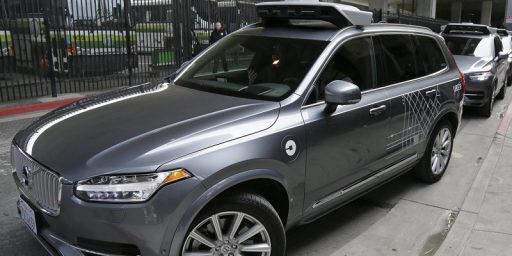Why We Drive on the Right – And Others Don’t
Monday, Samoa will switch to driving on the left side of the road in order to benefit from cheap used cars from Australia and New Zealand. This gave Time’s Randy James to explain, “Why Don’t We All Drive on the Same Side of the Road?” It’s especially odd that two-thirds of the world drives on the right, since most of us are right-handed and driving on the left is not only much more convenient but was the norm for centuries.
Theories differ, but there’s no doubt Napoleon was a major influence. The French have used the right since at least the late 18th century (there’s evidence of a Parisian “keep-right” law dating from 1794). Some say that, before the French Revolution, aristocrats drove their carriages on the left, forcing the peasantry to the right. Amid the upheaval, fearful aristocrats sought to blend in with the proletariat by traveling on the right as well. Regardless of the origin, Napoleon brought right-hand traffic to the nations he conquered, including Russia, Switzerland and Germany. (Hitler, in turn, ordered right-hand traffic in Czechoslovakia and Austria in the 1930s). Nations that escaped right-handed conquest, such as Great Britain, preserved their left-handed tradition.
Nor was the U.S. always a nation of right-hand drivers; earlier in its history, carriage and horse traffic traveled on the left, as it did in England. But by the late 1700s, the theory goes, teamsters driving large wagons pulled by several pairs of horses began prompting a shift to the right. A driver would sit on the rear left horse in order to wield his whip with his right hand; to see opposite traffic clearly, they traveled on the right.
One of the final moves to firmly standardize traffic directions in the U.S. occurred in the 20th century, when Henry Ford decided to mass-produce his cars with controls on the left (one reason, stated in a 1908 catalog: the convenience for passengers exiting directly onto the curb, “especially… if there is a lady to be considered.”) Once these norms were set, many countries eventually adjusted to conform to the right-hand standard, including Canada in the 1920s, Sweden in 1967 and Burma in 1970. The United Kingdom and former colonies such as Australia and India are among the western world’s few remaining holdouts.
One would think that the holdouts would switch to right-hand driving if simply for the ability to market their cars more easily. But, as the decades-long effort to switch the United States to the near ubiquitous and much simpler Metric system demonstrate, people fight very hard to hang on to cultural norms.






This carries over into social conventions as well.
I’ve work in IT jobs for thirty years, and there has been a presence of people from other cultures in places where I’ve worked for all of that time.
If you’re walking down a hallway (on the right) and someone is walking on their left straight at you, its invariably someone from India. Probably the British influence.
Case in point, Japan, which is one of the major non-British Colonies to drive on the left. I don’t think it’s hurt them in the least bit that they don’t drive on the same side of the road as us.
I meant to say “countries that were not British colonies”
We were almost there with metric, and could have completed the change-over with low cost. We’re still at least half metric.
On the other hand, the actual costs of a road-side change would be staggering. Not to mention the lives lost in the resulting adaption.
Metric never killed nobody.
Well, it’s forced them to make both right-hand and left-hand drive cars. Obviously, they’ve adapted. But it has to be less efficient than one assembly line setup.
Actually, it doesn’t matter–you can drive a right-hand car on a right-sided street.
My first car was a surplus US Mail Jeep–frickin thing rocked. Only problems were when I was going through the drive-though at Mickey-Ds, but I would just lean over to get my scrumptious victuals.
That’d make it easier to get the mail out of the ole mail box…though, going through a drive through food joint would be problematic.
I don’t understand all this nonsense about what side of the road to drive on. Anarcho-capitalist societies don’t have this problem: You drive on whatever side of the road you want–each is the custodian of his or her own safety. No pansy gubmint is going to tell me how to drive.
My grandfather (medieval historian) told me once the difference was due to the fact that British roads became heavily trafficked back when noblemen and their entourage had to be able to reach across for their swords; while roads in US and other right-drive countries typically became more heavily used when pistols were the weapon of choice. Have no idea if he was putting me on or not.
This post is more about where the controls are rather than the side of the road you drive on, although the two are related.
I’ve always been curious if it’s easier to use a stick shift with your left hand (assuming you are right-handed). Obviously it would initially feel awkward to those of us who are accustomed to shifting with our right hand and steering with our left, but I’m talking about if you learned to drive the opposite way. It seems like the steering wheel requires more precision which is better suited to your strong hand.
Furhead,
For me, left hand shift is easier, in fact I drive a right side drive manual car better than the other way. I don’t have any trouble switching back and forth when I travel to one of the few rsd countries that I visit (England/Ireland/South Africa).
The cost of switch over would be huge that is for sure.
MPW
I still can’t get used to the move of the dimmer switch from the floor to the steering column. My damn foot keeps getting stuck in the steering wheel….
Sam gave the view from the right. Here is the view from the left….
This is America, we believe in inclusion and diversity.. each driver should freely choose which lane in which to drive according to deeply held feelings. Only a transpophobe or xenophobe could disagree.
I hope that Samoa is also getting a new fleet of cheap used ambulances.
Only if you own the road.
What’s interrsting to me is that no matter which side you drive on, it’s common practice to put the driver as close to opposing traffic as possible. I wonder if the rate of fatalities would be lower if drivers were farther away from opposing traffic. I suppose it would depend on the rate at which people drive without passengers and the rate at which they hit stationary objects on their side of the road. Still, it’d be interresting to read a study on this issue.